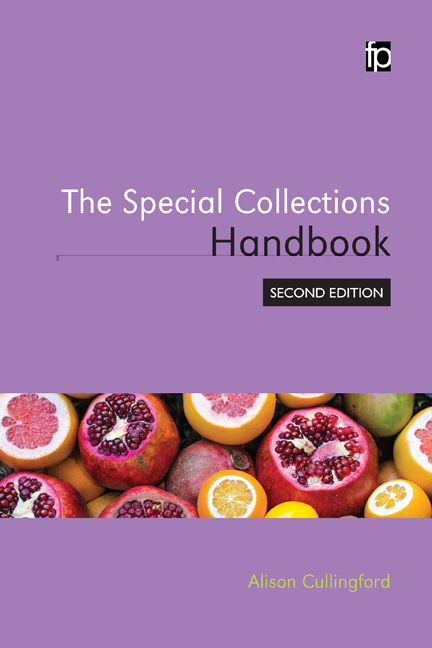Book contents
- Frontmatter
- Contents
- Preface and acknowledgements
- Introduction
- 1 The care of Special Collections
- 2 Emergency planning for Special Collections
- 3 Understanding objects in Special Collections
- 4 Acquiring and developing Special Collections
- 5 Cataloguing, description and metadata in Special Collections
- 6 Digitization and digital libraries in Special Collections
- 7 Legal and ethical issues in Special Collections
- 8 User services in Special Collections
- 9 Marketing and communications in Special Collections
- 10 Widening access to Special Collections
- 11 Organizational resources for Special Collections: space and people
- 12 Influencing and fund-raising for Special Collections
- Afterword: Special Collections futures
- Appendix A The Special Collections reference shelf
- Appendix B Skills for your Special Collections career
- Bibliography
- Index
8 - User services in Special Collections
- Frontmatter
- Contents
- Preface and acknowledgements
- Introduction
- 1 The care of Special Collections
- 2 Emergency planning for Special Collections
- 3 Understanding objects in Special Collections
- 4 Acquiring and developing Special Collections
- 5 Cataloguing, description and metadata in Special Collections
- 6 Digitization and digital libraries in Special Collections
- 7 Legal and ethical issues in Special Collections
- 8 User services in Special Collections
- 9 Marketing and communications in Special Collections
- 10 Widening access to Special Collections
- 11 Organizational resources for Special Collections: space and people
- 12 Influencing and fund-raising for Special Collections
- Afterword: Special Collections futures
- Appendix A The Special Collections reference shelf
- Appendix B Skills for your Special Collections career
- Bibliography
- Index
Summary
Introduction
Why do libraries care for collections, collect, catalogue and digitize them? So that people now and in the future can use them. This chapter is the first of three which consider the challenges of bringing people and collections together. Each takes a different perspective on user access: customer services, marketing and communication, and outreach. This chapter will cover individual services to users:
Discuss the nature of Special Collections users.
Discuss managing typical services: enquiries, physical visits, virtual and mobile visits, reprographics and inter-library loans.
Examine ways of improving services to users.
Understanding Special Collections users
In order to manage and improve user services, it is essential to understand who users are and why they might wish to use Special Collections. In Chapter 9, we consider ways of analysing users and how to develop new audiences in more detail. Here are some basics to consider.
Internal and external users of Special Collections
A crucial question is the relationship of a user to the library or parent organization:
Internal, for example members, staff or students of a university, trustees, or other employees. A finite and known population.
External, i.e. general public. Much more scope for growth, but also harder to analyse. External users are more likely to want remote or virtual services, but when they do visit will need opening hours that allow them plenty of contact with collections.
(Of course, an individual interested in particular Special Collections might be internal or external at different times of their life!).
The balance between internal and external users that is ‘right’ for a library will vary. Heavy internal use demonstrates value to the organization and helps maintain resources, but funding bodies will need evidence of use by external readers. In some libraries, for example subscription libraries or learned societies, internal users may be (and should be) dominant. However, if Special Collections contain unique and appealing material, and are marketed as discussed in this book, external people will want to use them, which may in turn benefit the parent organization.
- Type
- Chapter
- Information
- The Special Collections Handbook , pp. 147 - 168Publisher: FacetPrint publication year: 2016



